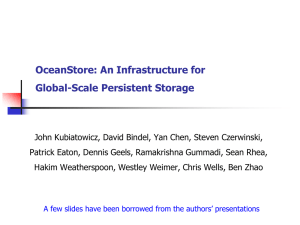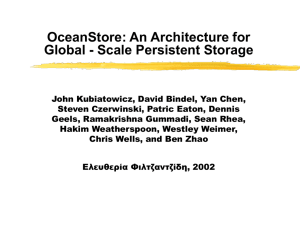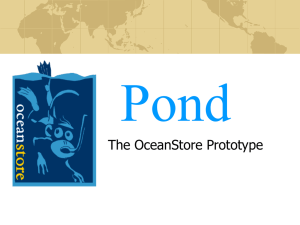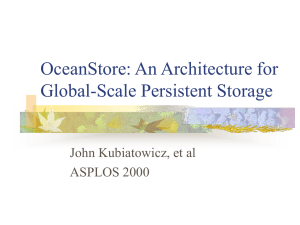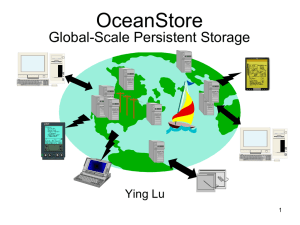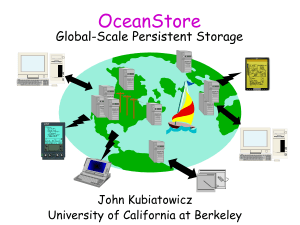An OceanStore Retrospective John Kubiatowicz University of California at Berkeley
advertisement
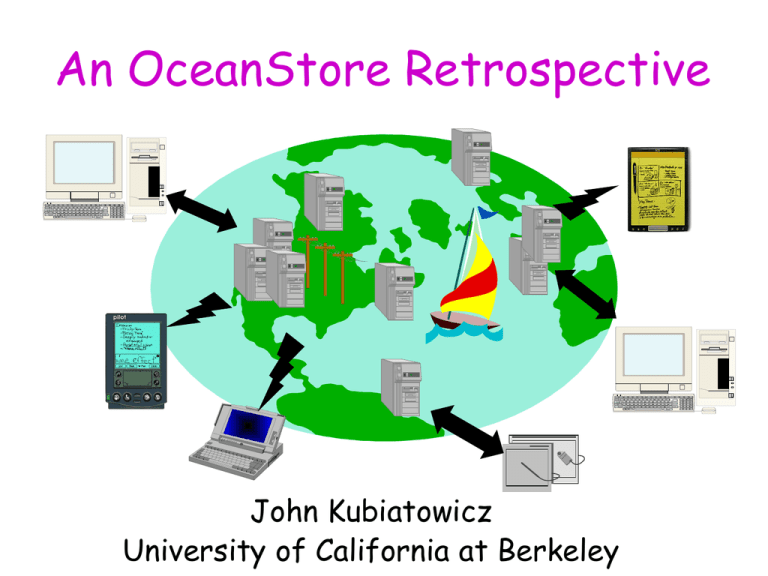
An OceanStore Retrospective
John Kubiatowicz
University of California at Berkeley
OceanStore Vision:
Utility-based Infrastructure
Canadian
OceanStore
Sprint
AT&T
Pac IBM
Bell
IBM
• Data service provided by storage federation
• Cross-administrative domain
• Contractual Quality of Service (“someone to sue”)
EMC OceanStore Retrospective
©2006 John Kubiatowicz/UC Berkeley
OceanStore:2
What are the advantages
of a utility?
• For Clients:
– Outsourcing of Responsibility
• Someone else worries about quality of service
– Better Reliability
• Utility can muster greater resources toward durability
• System not disabled by local outages
• Utility can focus resources (manpower) at securityvulnerable aspects of system
– Better data mobility
• Starting with secure network modelsharing
• For Utility Provider:
– Economies of scale
• Dynamically redistribute resources between clients
• Focused manpower can serve many clients simultaneously
EMC OceanStore Retrospective
©2006 John Kubiatowicz/UC Berkeley
OceanStore:3
Key Observation:
Want Automatic Maintenance
• Can’t possibly manage billions of servers by hand!
• System should automatically:
–
–
–
–
Adapt to failure
Exclude malicious elements
Repair itself
Incorporate new elements
• System should be secure and private
– Encryption, authentication
• System should preserve data over the long term
(accessible for 100s of years):
– Geographic distribution of information
– New servers added/Old servers removed
– Continuous Repair Data survives for long term
EMC OceanStore Retrospective
©2006 John Kubiatowicz/UC Berkeley
OceanStore:4
Why Peer-to-Peer?
EMC OceanStore Retrospective
©2006 John Kubiatowicz/UC Berkeley
OceanStore:5
Peer-to-Peer is:
• Old View:
– A bunch of flakey high-school students stealing music
• New View:
–
–
–
–
–
A philosophy of systems design at extreme scale
Probabilistic design when it is appropriate
New techniques aimed at unreliable components
A rethinking (and recasting) of distributed algorithms
Use of Physical, Biological, and Game-Theoretic
techniques to achieve guarantees
EMC OceanStore Retrospective
©2006 John Kubiatowicz/UC Berkeley
OceanStore:6
OceanStore Assumptions
Peer-to-peer
• Untrusted Infrastructure:
– The OceanStore is comprised of untrusted components
– Individual hardware has finite lifetimes
– All data encrypted within the infrastructure
• Mostly Well-Connected:
– Data producers and consumers are connected to a
high-bandwidth network most of the time
– Exploit multicast for quicker consistency when possible
• Promiscuous Caching:
– Data may be cached anywhere, anytime
• Responsible Party:
Quality-of-Service
– Some organization (i.e. service provider) guarantees
that your data is consistent and durable
– Not trusted with content of data, merely its integrity
EMC OceanStore Retrospective
©2006 John Kubiatowicz/UC Berkeley
OceanStore:7
Important Peer-to-Peer Service:
Decentralized Object Location and Routing
to Self-Verifying Handles (GUIDs)
GUID1
DOLR
GUID2
EMC OceanStore Retrospective
GUID1
©2006 John Kubiatowicz/UC Berkeley
OceanStore:8
The Tapestry DOLR:
Peer-to-peer Stability
(May 2003: 1.5 TB over 4 hours)
DOLR Model generalizes to many simultaneous apps
EMC OceanStore Retrospective
©2006 John Kubiatowicz/UC Berkeley
OceanStore:9
A Peek at
OceanStore
EMC OceanStore Retrospective
©2006 John Kubiatowicz/UC Berkeley
OceanStore:10
OceanStore Data Model
• Versioned Objects
– Every update generates a new version
– Can always go back in time (Time Travel)
• Each Version is Read-Only
– Can have permanent name
– Much easier to repair
• An Object is a signed mapping between
permanent name and latest version
– Write access control/integrity involves managing
these mappings
versions
Comet Analogy
EMC OceanStore Retrospective
©2006 John Kubiatowicz/UC Berkeley
updates
OceanStore:11
Self-Verifying Objects
AGUID = hash{name+keys}
VGUIDi
Data
B -Tree
VGUIDi + 1
backpointer
M
M
copy on
write
Indirect
Blocks
copy on
write
d1
d2
d3
Data
Blocks
d4 d5 d6
d7
d8
d'8 d'9
d9
Heartbeat: {AGUID,VGUID, Timestamp}signed
Heartbeats +
Read-Only Data
EMC OceanStore Retrospective
Updates
©2006 John Kubiatowicz/UC Berkeley
OceanStore:12
Two Types of OceanStore Data
• Active Data: “Floating Replicas”
– Per object virtual server
– Interaction with other replicas for consistency
– May appear and disappear like bubbles
• Archival Data: OceanStore’s Stable Store
– m-of-n coding: Like hologram
• Data coded into n fragments, any m of which are
sufficient to reconstruct (e.g m=16, n=64)
• Coding overhead is proportional to nm (e.g 4)
– Fragments are cryptographically self-verifying
• Most data in the OceanStore is archival!
EMC OceanStore Retrospective
©2006 John Kubiatowicz/UC Berkeley
OceanStore:13
Second-Tier
Caches
The Path of an
OceanStore Update
Inner-Ring
Servers
Clients
EMC OceanStore Retrospective
©2006 John Kubiatowicz/UC Berkeley
OceanStore:14
OceanStore API:
Universal Conflict Resolution
Native Clients NFS/AFS HTTP IMAP/SMTP NTFS (soon?)
OceanStore
API
1.
2.
3.
4.
Conflict Resolution
Versioning/Branching
Access control
Archival Storage
• Consistency is form of optimistic concurrency
– Updates contain predicate-action pairs
– Each predicate tried in turn:
• If none match, the update is aborted
• Otherwise, action of first true predicate is applied
• Role of Responsible Party (RP):
– Updates submitted to RP which chooses total order
EMC OceanStore Retrospective
©2006 John Kubiatowicz/UC Berkeley
OceanStore:15
Peer-to-Peer Caching:
Automatic Locality Management
Primary Copy
• Self-Organizing mechanisms to place replicas
• Automatic Construction of Update Multicast
EMC OceanStore Retrospective
©2006 John Kubiatowicz/UC Berkeley
OceanStore:16
Archival Dissemination
of Fragments
Archival
Servers
Archival
Servers
EMC OceanStore Retrospective
©2006 John Kubiatowicz/UC Berkeley
OceanStore:17
Extreme Durability
• Exploiting Infrastructure for Repair
– DOLR permits efficient heartbeat mechanism to
notice:
• Servers going away for a while
• Or, going away forever!
– Continuous sweep through data also possible
– Erasure Code provides Flexibility in Timing
• Data transferred from physical medium to
physical medium
– No “tapes decaying in basement”
– Information becomes fully Virtualized
• Thermodynamic Analogy: Use of Energy (supplied
by servers) to Suppress Entropy
EMC OceanStore Retrospective
©2006 John Kubiatowicz/UC Berkeley
OceanStore:18
PondStore
Prototype
EMC OceanStore Retrospective
©2006 John Kubiatowicz/UC Berkeley
OceanStore:19
OceanStore Prototype
• All major subsystems operational
–
–
–
–
–
Self-organizing Tapestry base
Primary replicas use Byzantine agreement
Secondary replicas self-organize into multicast tree
Erasure-coding archive
Application interfaces: NFS, IMAP/SMTP, HTTP
• 280K lines of Java (J2SE v1.3)
– JNI libraries for cryptography, erasure coding
• PlanetLab Deployment (FAST 2003, “Pond” paper)
– 220 machines at 100 sites
in North America, Europe,
Australia, Asia, etc.
– 1.26Ghz PIII (1GB RAM),
1.8Ghz PIV (2GB RAM)
– OceanStore code running
with 1000 virtual-node
emulations
EMC OceanStore Retrospective
©2006 John Kubiatowicz/UC Berkeley
OceanStore:20
Event-Driven Architecture
of an OceanStore Node
• Data-flow style
World
– Arrows Indicate flow of messages
• Potential to exploit small multiprocessors at
each physical node
EMC OceanStore Retrospective
©2006 John Kubiatowicz/UC Berkeley
OceanStore:21
Why aren’t we using
Pond every Day?
EMC OceanStore Retrospective
©2006 John Kubiatowicz/UC Berkeley
OceanStore:22
Problem #1: DOLR is Great Enabler—
but only if it is stable
• Had Reasonable Stability:
– In simulation
– Or with small error rate
• But trouble in wide area:
– Nodes might be lost and
never reintegrate
– Routing state might
become stale or be lost
• Why?
– Complexity of algorithms
– Wrong design paradigm: strict rather than loose state
– Immediate repair of faults
• Ultimately, Tapestry Routing Framework succumbed to:
– Creeping Featurism (designed by several people)
– Fragilility under churn
– Code Bloat
EMC OceanStore Retrospective
©2006 John Kubiatowicz/UC Berkeley
OceanStore:23
Answer: Bamboo!
• Simple, Stable, Targeting Failure
• Rethinking of design of Tapestry:
– Separation of correctness from performance
– Periodic recovery instead of reactive recovery
– Network understanding
(e.g. timeout calculation)
– Simpler Node Integration
(smaller amount of state)
• Extensive testing under
Churn and partition
• Bamboo is so stable that
it is part of the OpenHash
public DHT infrastructure.
• In wide use by many researchers
EMC OceanStore Retrospective
©2006 John Kubiatowicz/UC Berkeley
OceanStore:24
Problem #2: Pond Write Latency
• Byzantine algorithm adapted from Castro &
Liskov
– Gives fault tolerance, security against compromise
– Fast version uses symmetric cryptography
• Pond uses threshold signatures instead
– Signature proves that f +1 primary replicas agreed
– Can be shared among secondary replicas
– Can also change primaries w/o changing public key
• Big plus for maintenance costs
– Results good for all time once signed
– Replace faulty/compromised servers transparently
EMC OceanStore Retrospective
©2006 John Kubiatowicz/UC Berkeley
OceanStore:25
Closer Look: Write Cost
• Small writes
–
–
–
–
Signature dominates
Threshold sigs. slow!
Takes 70+ ms to sign
Compare to 5 ms
for regular sigs.
• Large writes
– Encoding dominates
– Archive cost per byte
– Signature cost per write
4 kB
write
2 MB
write
Phase
Validate
0.3
0.4
Serialize
6.1 26.6
Apply
1.5 113.0
Archive
4.5 566.9
Sign Result
77.8 75.8
(times in milliseconds)
• Answer: Reduction in overheads
– More Powerful Hardware at Core
– Cryptographic Hardware
• Would greatly reduce write cost
• Possible use of ECC or other signature method
– Offloading of Archival Encoding
EMC OceanStore Retrospective
©2006 John Kubiatowicz/UC Berkeley
OceanStore:26
Problem #3: Efficiency
• No resource aggregation
– Small blocks spread widely
– Every block of every file on different set of servers
– Not uniquely OceanStore issue!
• Answer: Two-Level Naming
– Place data in larger chunks (‘extents’)
– Individual access of blocks by name within extents
get( E1,R1 )
V2 R2 I3 B6
B5 V1 R1 I2
E1
B4 B3 I1 B2 B1
E0
– Bonus: Secure Log good interface for secure archive
– Antiquity: New Prototype for archival storage
EMC OceanStore Retrospective
©2006 John Kubiatowicz/UC Berkeley
OceanStore:27
Problem #4: Complexity
• Several of the mechanisms were complex
– Ideas were simple, but implementation was complex
– Data format combination of live and archival features
– Byzantine Agreement hard to get right
• Ideal layering not obvious at beginning of project:
– Many Applications Features placed into Tapestry
– Components not autonomous, i.e. able to be tied in at any
moment and restored at any moment
• Top-down design lost during thinking and
experimentation
• Everywhere: reactive recovery of state
– Original Philosophy: Get it right once, then repair
– Much Better: keep working toward ideal
(but assume never make it)
EMC OceanStore Retrospective
©2006 John Kubiatowicz/UC Berkeley
OceanStore:28
Other Issues/Ongoing Work:
• Archival Repair Expensive if done incorrectly:
– Small blocks consume excessive storage and
network bandwidth
– Transient failures consume unnecessary repair bandwidth
– Solutions: collect blocks into extents and use threshold repair
• Resource Management Issues
– Denial of Service/Over Utilization of Storage serious threat
– Solution: Exciting new work on fair allocation
• Inner Ring provides incomplete solution:
– Complexity with Byzantine agreement algorithm is a problem
– Working on better Distributed key generation
– Better Access control + secure hardware + simpler Byzantine
Algorithm?
• Handling of low-bandwidth links and Partial Disconnection
– Improved efficiency of data storage
– Scheduling of links
– Resources are never unbounded
• Better Replica placement through game theory
EMC OceanStore Retrospective
©2006 John Kubiatowicz/UC Berkeley
OceanStore:29
What is next?
EMC OceanStore Retrospective
©2006 John Kubiatowicz/UC Berkeley
OceanStore:30
Bamboo OpenDHT
• PL deployment running for several months
• Put/get via RPC over TCP
• Looking for new users/New applications
EMC OceanStore Retrospective
©2006 John Kubiatowicz/UC Berkeley
OceanStore:31
The Berkeley PetaByte
Archival Service
• OceanStore Concepts Applied to Tape-less backup
– Self-Replicating, Self-Repairing, Self-Managing
– No need for actual Tape in system
• (Although could be there to keep with tradition)
EMC OceanStore Retrospective
©2006 John Kubiatowicz/UC Berkeley
OceanStore:32
OceanStore Archive Antiquity
• Secure Log:
– Can only modify at one point – log head.
• Makes consistency easier
– Self-verifying
• Every entry securely points to previous forming Merkle
chain
• Prevents substitution attacks
– Random read access – can still read efficiently
• Simple and secure primitive for storage
– Log identified by cryptographic key pair
– Only owner of private key can modify log
– Thin interface, only append()
• Amenable to secure, durable implementation
– Byzantine quorum of storage servers
• Can survive failures at O(n) cost instead of O(n2) cost
– Efficiency through aggregation
• Use of Extents and Two-Level naming
EMC OceanStore Retrospective
©2006 John Kubiatowicz/UC Berkeley
OceanStore:33
Antiquity Architecture:
Universal Secure Middleware
Replicated
Service
App
– Creator of data
• Client
– Direct user of system
• “Middleware”
• End-user, Server,
Replicated service
– append()’s to log
– Signs requests
V1 R1 I2 B4 B3 I1 B2 B1
• Data Source
V1 R1 I2 B4 B3 I1 B2 B1
Storage System
V1 R1 I2 B4 B3 I1 B2 B1
• Storage Servers
– Store log replicas on disk
– Dynamic Byzantine quorums
• Consistency and durability
• Administrator
– Selects storage servers
App
Server
App
• Prototype currently operational on PlanetLab
EMC OceanStore Retrospective
©2006 John Kubiatowicz/UC Berkeley
OceanStore:34
Secure Object Storage
Client
(w/ TCPA)
OceanStore
Client
(w/ TCPA)
Client
Data
Manager
Client
(w/ TCPA)
• Security: Access and Content controlled by client
– Privacy through data encryption
– Optional use of cryptographic hardware for revocation
– Authenticity through hashing and active integrity checking
• Flexible self-management and optimization:
– Performance and durability
– Efficient sharing
EMC OceanStore Retrospective
©2006 John Kubiatowicz/UC Berkeley
OceanStore:35
For more info:
http://oceanstore.org
• OceanStore vision paper for ASPLOS 2000
“OceanStore: An Architecture for Global-Scale
Persistent Storage”
• Pond Implementation paper for FAST 2003
“Pond: the OceanStore Prototype”
• Tapestry deployment paper (JSAC, to appear)
“Tapestry: A Resilient Global-scale Overlay for
Service Deployment”
• Bamboo Paper for Usenix 2004
“Handling Churn in a DHT”
• OpenDHT Paper for SigCOMM 2005
“OpenDHT: A Public DHT Service”
EMC OceanStore Retrospective
©2006 John Kubiatowicz/UC Berkeley
OceanStore:36
Backup Slides
EMC OceanStore Retrospective
©2006 John Kubiatowicz/UC Berkeley
OceanStore:37
Closer Look: Write Cost
(run on cluster)
EMC OceanStore Retrospective
©2006 John Kubiatowicz/UC Berkeley
OceanStore:38
Secure Naming
Out-of-Band
“Root link”
Foo
Bar
Baz
Myfile
• Naming hierarchy:
– Users map from names to GUIDs via hierarchy of
OceanStore objects (ala SDSI)
– Requires set of “root keys” to be acquired by user
EMC OceanStore Retrospective
©2006 John Kubiatowicz/UC Berkeley
OceanStore:39
The Thermodynamic Analogy
• Large Systems have a variety of latent order
– Connections between elements
– Mathematical structure (erasure coding, etc)
– Distributions peaked about some desired behavior
• Permits “Stability through Statistics”
– Exploit the behavior of aggregates (redundancy)
• Subject to Entropy
– Servers fail, attacks happen, system changes
• Requires continuous repair
– Apply energy (i.e. through servers) to reduce entropy
EMC OceanStore Retrospective
©2006 John Kubiatowicz/UC Berkeley
OceanStore:40
The Biological Inspiration
• Biological Systems are built from (extremely)
faulty components, yet:
– They operate with a variety of component failures
Redundancy of function and representation
– They have stable behavior Negative feedback
– They are self-tuning Optimization of common case
• Introspective (Autonomic)
Computing:
– Components for performing
Dance
– Components for monitoring and
model building
– Components for continuous
adaptation
Adapt Monitor
EMC OceanStore Retrospective
©2006 John Kubiatowicz/UC Berkeley
OceanStore:41
Basic Tapestry Mesh
Incremental Prefix-based Routing
3
4
NodeID
0xEF97
NodeID
0xEF32
NodeID
0xE399
4
NodeID
0xE530
3
NodeID
0xEF34
4
NodeID
0xEF37
3
NodeID
0xEF44
2
2
4
3
1
1
3
NodeID
0x099F
2
3
NodeID
0xE555
1
NodeID
0xFF37
EMC OceanStore Retrospective
2
NodeID
0xEFBA
NodeID
0xEF40
NodeID
0xEF31
4
NodeID
0x0999
1
2
2
3
NodeID
0xE324
NodeID
0xE932
©2006 John Kubiatowicz/UC Berkeley
1
NodeID
0x0921
OceanStore:42
Use of Tapestry Mesh
Randomization and Locality
EMC OceanStore Retrospective
©2006 John Kubiatowicz/UC Berkeley
OceanStore:43
Single Node Tapestry
Application-Level
Multicast
OceanStore
Other
Applications
Application Interface / Upcall API
Dynamic Node
Management
Routing Table
&
Router
Object Pointer DB
Network Link Management
Transport Protocols
EMC OceanStore Retrospective
©2006 John Kubiatowicz/UC Berkeley
OceanStore:44
Object Location
RDP (min, median, 90%)
25
20
15
10
5
0
0
20
40
60
80
100
120
140
160
180
200
Client to Obj RTT Ping time (1ms buckets)
EMC OceanStore Retrospective
©2006 John Kubiatowicz/UC Berkeley
OceanStore:45
Tradeoff: Storage vs Locality
EMC OceanStore Retrospective
©2006 John Kubiatowicz/UC Berkeley
OceanStore:46
Aside: Why erasure coding?
High Durability/overhead ratio!
Fraction Blocks Lost
Per Year (FBLPY)
• Exploit law of large numbers for durability!
• 6 month repair, FBLPY:
– Replication: 0.03
– Fragmentation: 10-35
EMC OceanStore Retrospective
©2006 John Kubiatowicz/UC Berkeley
OceanStore:47
Statistical Advantage of Fragments
Time to Coalesce vs. Fragments Requested (TI5000)
180
160
140
Latency
120
100
80
60
40
20
0
16
17
18
19
20
21
22
23
24
25
26
27
28
29
30
31
Objects Requested
• Latency and standard deviation reduced:
– Memory-less latency model
– Rate ½ code with 32 total fragments
EMC OceanStore Retrospective
©2006 John Kubiatowicz/UC Berkeley
OceanStore:48
Self-Organized
Replication
EMC OceanStore Retrospective
©2006 John Kubiatowicz/UC Berkeley
OceanStore:49
Effectiveness of second tier
EMC OceanStore Retrospective
©2006 John Kubiatowicz/UC Berkeley
OceanStore:50
Second Tier Adaptation:
Flash Crowd
• Actual Web Cache running on OceanStore
– Replica 1 far away
– Replica 2 close to most requestors (created t ~ 20)
– Replica 3 close to rest of requestors (created t ~ 40)
EMC OceanStore Retrospective
©2006 John Kubiatowicz/UC Berkeley
OceanStore:51
Introspective Optimization
• Secondary tier self-organized into
overlay multicast tree:
– Presence of DOLR with locality to suggest placement
of replicas in the infrastructure
– Automatic choice between update vs invalidate
• Continuous monitoring of access patterns:
– Clustering algorithms to discover object relationships
• Clustered prefetching: demand-fetching related objects
• Proactive-prefetching: get data there before needed
– Time series-analysis of user and data motion
• Placement of Replicas to Increase Availability
EMC OceanStore Retrospective
©2006 John Kubiatowicz/UC Berkeley
OceanStore:52
Parallel Insertion Algorithms
(SPAA ’02)
• Massive parallel insert is important
– We now have algorithms that handle “arbitrary
simultaneous inserts”
– Construction of nearest-neighbor mesh links
• Log2 n message complexityfully operational routing
mesh
– Objects kept available during this process
• Incremental movement of pointers
• Interesting Issue: Introduction service
– How does a new node find a gateway into the
Tapestry?
EMC OceanStore Retrospective
©2006 John Kubiatowicz/UC Berkeley
OceanStore:53
Can You Delete (Eradicate) Data?
• Eradication is antithetical to durability!
– If you can eradicate something, then so can someone else!
(denial of service)
– Must have “eradication certificate” or similar
• Some answers:
– Bays: limit the scope of data flows
– Ninja Monkeys: hunt and destroy with certificate
• Related: Revocation of keys
– Need hunt and re-encrypt operation
• Related: Version pruning
–
–
–
–
Temporary files: don’t keep versions for long
Streaming, real-time broadcasts: Keep? Maybe
Locks: Keep? No, Yes, Maybe (auditing!)
Every key stroke made: Keep? For a short while?
EMC OceanStore Retrospective
©2006 John Kubiatowicz/UC Berkeley
OceanStore:54
